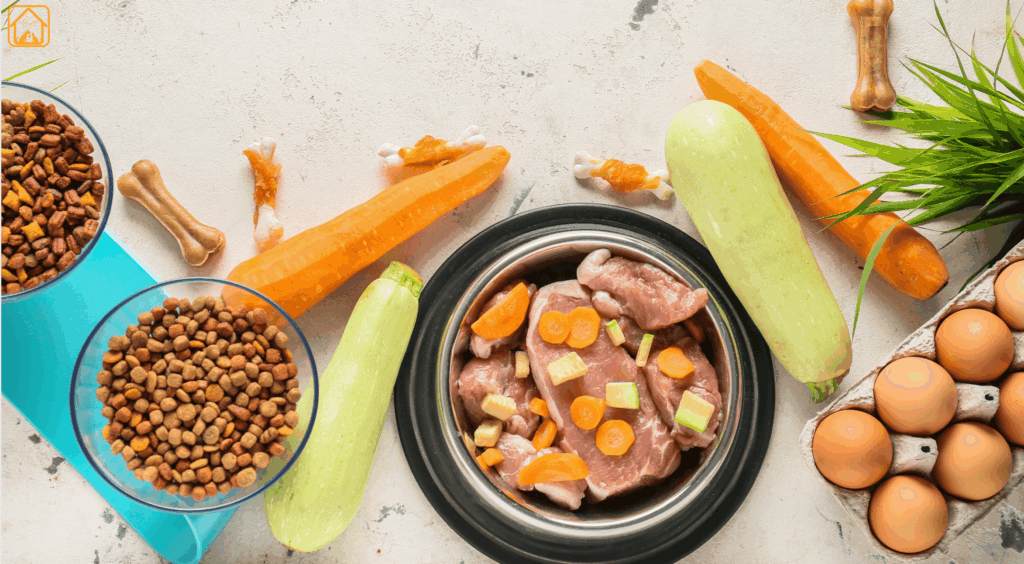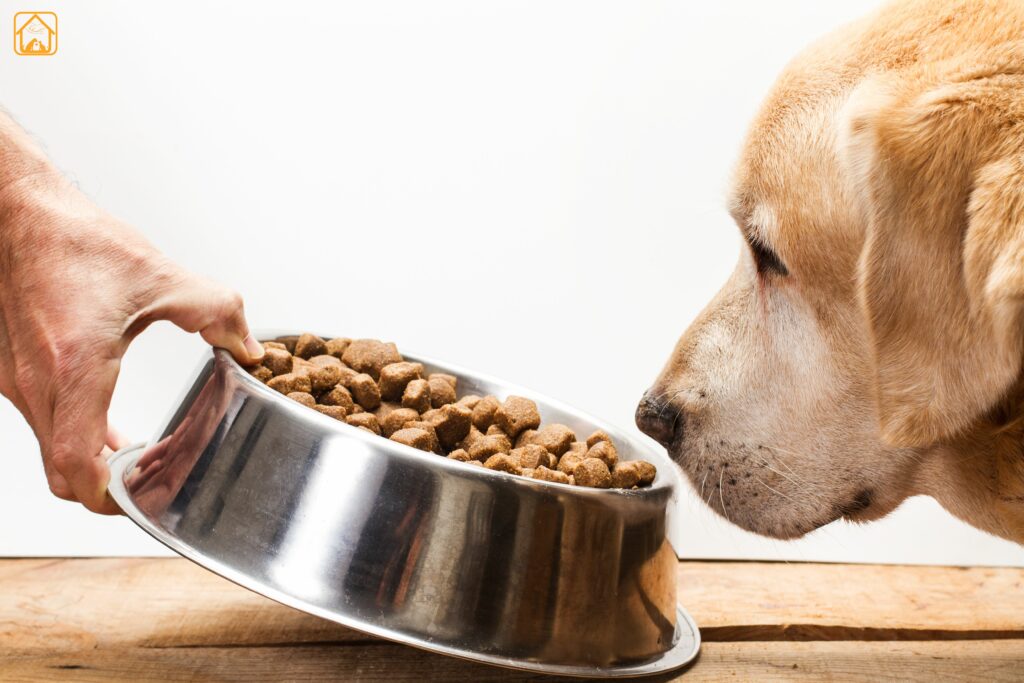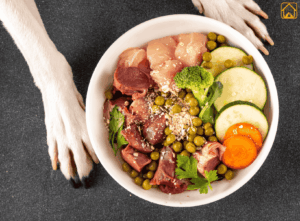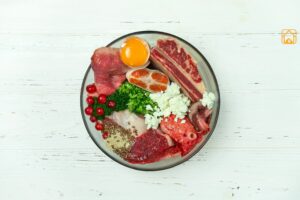Why Proper Feeding Matters for Labradors?
Labrador feeding isn’t just about filling a bowl. The right nutrition directly shapes your Lab’s energy, coat, digestion, and even their mood. Labs are especially prone to weight gain, joint issues, and food sensitivities. A well-balanced Labrador feeding routine supports strong muscles, healthy joints, and a shiny coat.
Finding the right balance in your dog’s diet and care can be the difference between a tail-wagging, energetic pup and one struggling with avoidable health issues. A little extra care today can lead to a much happier tomorrow for your furry friend.
Key Nutritional Requirements for Labradors
Protein, Fat, and Carbs: What Labs Really Need
Labradors thrive on high-quality nutrition. They need:
- High-quality protein: Chicken, lamb, fish, beef, protein is the building block for strong muscles and healthy skin. Aim for 22-30% protein in your Lab’s diet, especially during puppyhood.
- Healthy fats: Not all fats are created equal. Omega-3 and Omega-6 fatty acids (from fish oil or flaxseed) keep coats shiny and brains sharp.
- Complex carbohydrates: Sweet potato, brown rice, oats, or barley provide lasting energy. Avoid foods heavy in corn or wheat fillers.
- Essential vitamins and minerals: Calcium, phosphorus, zinc, vitamin A, and E are crucial for bone growth, immune health, and overall vitality.
Labs also benefit from added glucosamine for joint health and omega-3s for their skin. Always check your dog food label for these elements. The right balance helps avoid issues like obesity or allergies.
Labrador Feeding Chart by Age
Labrador puppies grow quickly, so their food must deliver the right balance of calories, protein, calcium, and phosphorus. Overfeeding can lead to excessive weight gain and joint problems, while underfeeding may stunt growth. The best approach is to follow a labrador puppy feeding chart tailored to their age and weight.
How Often Should You Feed a Lab Puppy?
- 1-3 months: 4 meals per day
- 4-6 months: 3 meals per day
- 6-12 months: 2 meals per day
Consistency is key, feed at the same times daily to help with digestion and house training.
What Is the Best Food for Labrador Puppies?
Choose high-quality, large-breed puppy food. Look for:
- Animal protein (chicken, lamb, fish) as the first ingredient
- Balanced calcium and phosphorus for bone health
- Minimum fillers and artificial additives
- Omega-3 fatty acids (from fish oil) for brain and vision development
If you prefer homemade or raw food, consult a veterinary nutritionist to ensure your puppy receives complete, balanced nutrition.
Sample Labrador Puppy Feeding Schedule
- 7:00 AM – Breakfast
- 12:00 PM – Lunch
- 4:00 PM – Dinner
- 8:00 PM – Last meal (for younger puppies)
Always provide plenty of fresh water. Avoid cow’s milk because it can upset their tummy.
Here is the quick table of Puppy Feeding Schedule
| Age | Weight (kg) | Daily Amount (gm) | Meals/Day |
| 1-2 months | 2-4 | 150-200 | 4-5 |
| 2-4 months | 4-8 | 200-300 | 4 |
| 4-6 months | 8-15 | 250-400 | 3 |
| 6-12 months | 15-25 | 300-450 | 2-3 |
Tips for Healthy Puppy Feeding:
- Weigh your puppy weekly to track growth
- Adjust portions if they’re gaining too much or too little weight
- Transition to adult food at 12-15 months, unless advised otherwise by your vet
- Use puzzle feeders for mental stimulation and to slow fast eaters
For more age-specific advice, visit our puppy feeding guide.
Feeding Adult & Senior Labradors: Adjusting Diet for Life Stage
As your Labrador matures, their dietary needs shift. Adult and senior Labs require careful portion control and tailored nutrition to maintain healthy weight, support joint health, and keep them active for years to come.
Adult Labrador Feeding Guide (1-7 Years)
- Meals per day: 2
- Average daily food: 350-450g (depending on size, activity, and food type)
- Focus: Balanced protein, moderate fat, joint-supporting nutrients
Choose premium adult dog food designed for large breeds. Look for:
- First ingredient as real meat or fish
- Glucosamine and chondroitin for joint support
- Omega fatty acids for coat and skin health
- Limited fillers, artificial colors, or preservatives
Portion Control Tip: Labradors are prone to obesity. Monitor their body condition, ribs should be felt easily but not seen. Adjust portions as needed based on activity level. Treats should make up less than 10% of daily calories.
Senior Labrador Feeding Guide (7+ Years)
- Meals per day: 2 (smaller portions, if needed)
- Average daily food: 300-400g (adjust for weight and activity)
- Focus: Lower calories, high-quality protein, joint and cognitive support
Senior dogs benefit from diets with extra antioxidants, joint supplements, and easily digestible ingredients. Some Labs may need special diets for kidney, heart, or mobility concerns consult your vet regularly.
Common Feeding Questions for Adult & Senior Labs:
- Should I feed dry or wet food? Both are options; dry food is convenient and supports dental health, while wet food is more palatable and hydrating. Mixing can work well, too.
- What about homemade or raw diets? These can be healthy if well-balanced. Better a seek guidance from a veterinary nutritionist.
- How do I transition foods? Switch gradually over 5-7 days to avoid stomach upset.
Signs Your Lab’s Diet Needs Adjusting:
- Sudden weight gain or loss
- Change in coat quality, itching, or digestive issues
- Reduced energy or mobility
Remember, every Lab is special. With regular checkups, portion control, and an eye on their body condition, you’ll help your best friend thrive at every age. For more age-specific advice, visit our adult dog feeding and senior dogs diet.
Best Foods for Labrador Retrievers: Kibble, Raw, and Homemade Options

Choosing the Right Diet for Your Lab
- High-Quality Kibble: A good quality kibble made with real meat and fewer fillers can be a lifesaver for busy pet parents. Just make sure it’s made for large breeds or specially formulated for Labradors to support their joints and energy levels.
- Raw Food Diet: Some Lab owners find raw feeding (like the BARF diet) helps with digestion and coat health. But it’s not for everyone, it takes careful planning, especially for growing pups. Always talk to your vet before making the switch.
- Homemade Diets: Home-cooked meals like boiled chicken, rice, and veggies can work wonders if done right. I’ve seen Labradors do great on them, but the key is making sure they’re getting all the nutrients they need, no shortcuts here.
Mixing wet food, toppers, or healthy treats can keep your Lab excited about meals. The best food for Labrador Retrievers is one they digest well, maintain a healthy weight on, and truly enjoy.
Check out our homemade dog food guide for tips on making delicious and healthy meals for your lovable Lab pup.
Labrador Feeding Tips
- Transition new foods slowly, mix 25% new food with 75% old, increasing new food over 7 days.
- For picky eaters, try warming the food or adding a spoon of unsalted broth. Sometimes, Labs get bored and need a little variety.
- Big dietary changes (like from kibble to raw) should be supervised by a vet or pet nutritionist.
- If your Lab skips a meal but seems happy, don’t panic. But if they skip more than 1 meal or show signs of illness, call your vet.
Portion Control and Weight Management
Keeping Labs Lean and Healthy
- Always measure your Lab’s meals using a proper cup or kitchen scale. Eyeballing portions often leads to extra pounds.
- Treats should make up no more than 10% of their daily intake. If your Lab needs to slim down, try healthy options like carrot sticks or green beans.
- Check their body condition regularly, you should be able to feel their ribs with light pressure, but not see them.
- If weight is creeping up, talk to your vet. Reducing meals slightly and adding more walks or play can make a big difference.
Labs love eating, and it’s easy to overfeed, especially when visitors sneak snacks. I had to create “treat rules” at home just to keep Bunny from turning into a couch potato!
Common Feeding Mistakes & Foods to Avoid for Labradors
Even the most loving pet parents can make mistakes when it comes to labrador feeding. Here are some of the most frequent mistakes and how to avoid them to keep your Lab safe and thriving.
Top Feeding Mistakes
- Overfeeding: Labs are prone to obesity, so it’s easy to give too much food (or too many treats). Stick to measured portions and monitor your dog’s body condition regularly.
- Feeding Table Scraps: Many human foods (even seemingly harmless ones like bread or fatty meat) can upset your Lab’s stomach or add unnecessary calories.
- Sudden Diet Changes: Abruptly switching foods may cause digestive upset. Always transition gradually over 5–7 days.
- Ignoring Food Labels: Not all dog foods are created equal. Avoid brands with unnamed “meat by-products,” excessive fillers, or artificial colors/flavors.
- Free Feeding: Leaving food out all day encourages overeating and makes weight management difficult.
- Not Considering Age or Health: Feeding a puppy adult food, or ignoring special health needs, can lead to deficiencies or excesses.
Dangerous Foods for Labradors
- Chocolate (toxic, even in small amounts)
- Grapes & Raisins (can cause kidney failure)
- Onions & Garlic (damage red blood cells)
- Cooked Bones (splinter and may cause blockages)
- Alcohol, Caffeine, Xylitol (artificial sweetener)
For a full list, see the ASPCA toxic foods list. If your Lab ingests something dangerous, contact your vet immediately.
Other Foods to Limit or Avoid
- High-fat meats (can cause pancreatitis)
- Dairy (many Labs are lactose intolerant)
- Raw eggs (risk of salmonella and biotin deficiency)
- Raw bread dough (can expand in the stomach)
- Salt-heavy foods (may lead to dehydration or sodium poisoning)
Pro Tip: If you want to share a treat, opt for safe fruits like apple slices (without seeds), carrots, or small bits of cooked, lean meat. Always in moderation!
FAQs: Labrador Feeding Questions Answered
How much should I feed my Labrador puppy?
Use a labrador puppy feeding chart as a guide: typically 200-300g per day divided into 3-4 meals, adjusting for weight and appetite.
What’s the best food for Labrador Retrievers?
Look for large-breed formulas with real meat as the first ingredient, balanced fats, and no artificial fillers. Top-rated brands or vet-recommended foods are safest.
Can I feed my Labrador homemade food?
Yes, but recipes must be nutritionally balanced. Consult a vet or pet nutritionist to avoid deficiencies. Homemade diets can be great when done right.
Should I choose kibble, raw, or wet food for my Lab?
Each has pros and cons. Kibble is convenient, raw can offer fresh ingredients, and some Labs enjoy wet food as a topper. Choose what fits your lifestyle and your dog’s needs.
How often should I change my Labrador’s food?
Change only if necessary (allergies, life stage, health issues). Always transition slowly over a week to prevent digestive upset.
How can I help my overweight Labrador lose weight?
Reduce portion size, increase activity, choose lower-calorie foods, and use healthy treats like carrots. Your vet can help create a labrador feeding plan for weight loss.
Is it normal for Labradors to always act hungry?
Yes! Labs are notorious for begging, even when full. Stick to measured meals and ignore the puppy-dog eyes. If your Lab is losing weight or seems obsessed with food, check with your vet.
Conclusion
As I said in the article, feeding your Labrador the right way isn’t just about filling a bowl, it’s about setting them up for a long, healthy, and happy life. From choosing quality food to managing portions and understanding their unique needs, every decision counts.
Labs love to eat, so balance, consistency, and a little extra care go a long way. Whether you’re feeding kibble, home-cooked meals, or trying an allergy-friendly diet, always keep your Lab’s energy, age, and lifestyle in mind. And when in doubt, your vet is your best partner in making smart feeding choices.



